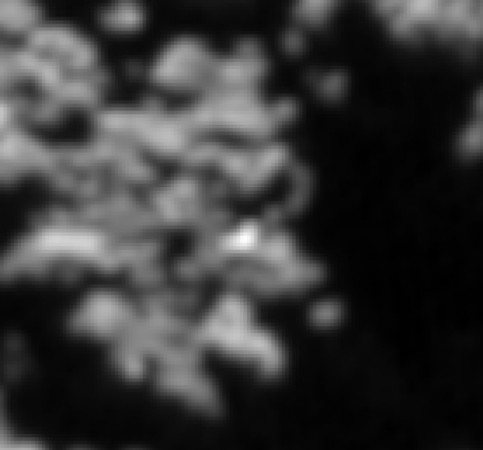
The European Space Agency’s lost lander, Philae, may have been rediscovered by researchers. After trawling through images of comet 67P/Churyumov-Gerasimenko, ESA scientists believe they have identified a tiny, bright spot where the unresponsive Rosetta lander is situated.
Philae’s original landing didn’t quite go according to plan, with the probe failing to deploy its harpoons properly. With the lander unsecured, it bounced away and drifted for several hours, eventually touching down at an awkward angle on a shady part of the comet’s Abydos region. Alas, in the absence of any sunlight, Philae’s battery started to run low, triggering its hibernation after only three days of operation on the comet. The lander remains in safe mode, and cannot make contact with Rosetta.

A team of scientists has deduced, what they consider to be, Philae’s current whereabouts. To establish Philae’s location, the team used the probe’s previous trajectory and information from its CONSERT instrument. CONSERT was designed to examine the internal structure of 67P/Churyumov-Gerasimenko by transmitting radio waves, from Rosetta, through the nucleus of the comet, ready for Philae to detect. These data gave the team a rough approximation of Philae’s location, which is likely somewhere in a 16 meter by 160 meter area.
ESA researchers have also adopted another approach to track down Philae. Looking at the images snapped by Rosetta’s camera in December, researchers have noticed several small glints of light on 67P/Churyumov-Gerasimenko’s surface. Since Philae landed in a shaded part of the comet, any reflections from the lander’s solar panels will contrast against its dark surroundings. The team used before and after shots of Philae’s landing to whittle down the possible list of locations.
“This bright spot is visible on two different images taken in December 2014, clearly indicating that it is a real feature on the surface of the comet, not a detector artefact or moving foreground dust speck,” explained Philippe Lamy of the OSIRIS imager group.
The scientists found that the results of the image comparisons stacked up with predictions made using the CONSERT data. While this provides reason for hope, the ESA remains wary of its findings. It’s still possible that the image of the bright spot is the result newly “exposed material.”
The team hopes Philae will soon receive the burst of sunlight it needs to power back online, as it approaches the Sun. If Philae emerges from hibernation, it will be able to make contact with Rosetta, allowing the team to find its exact location.
